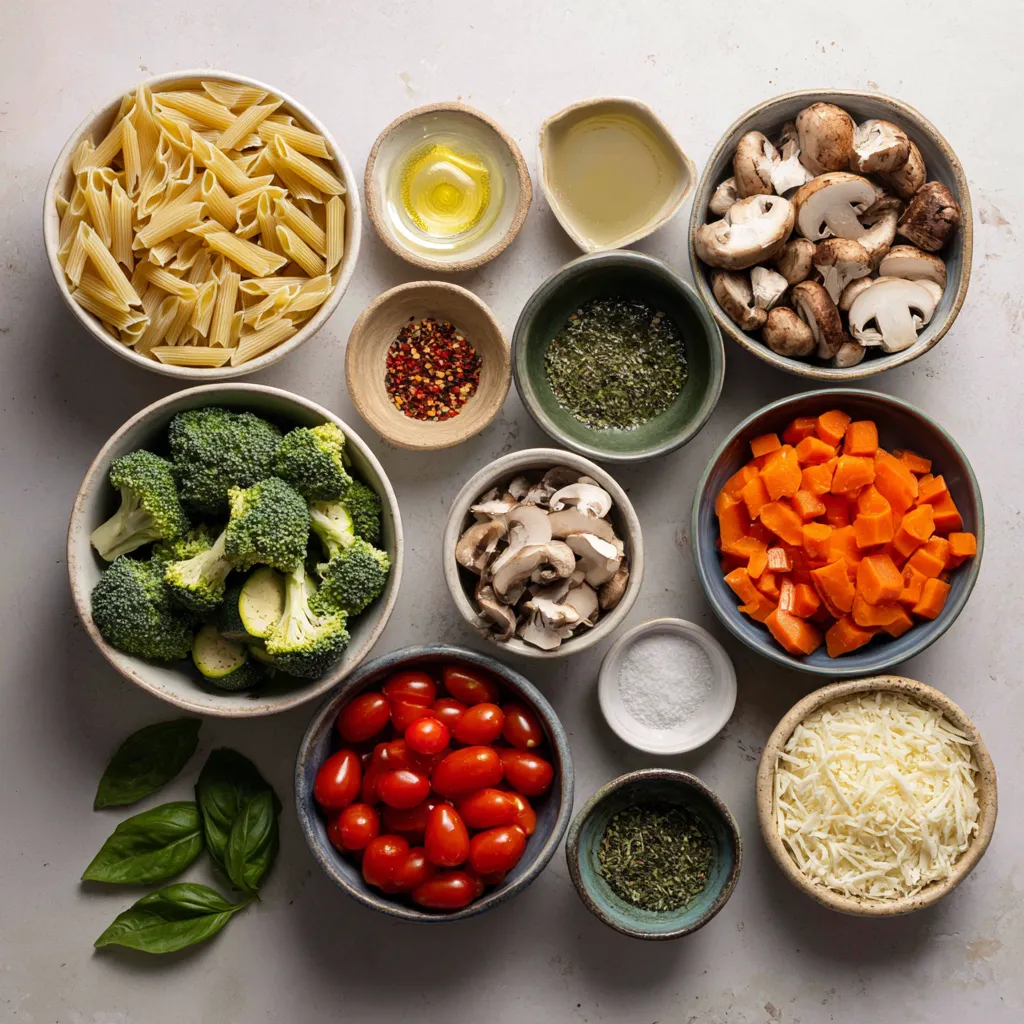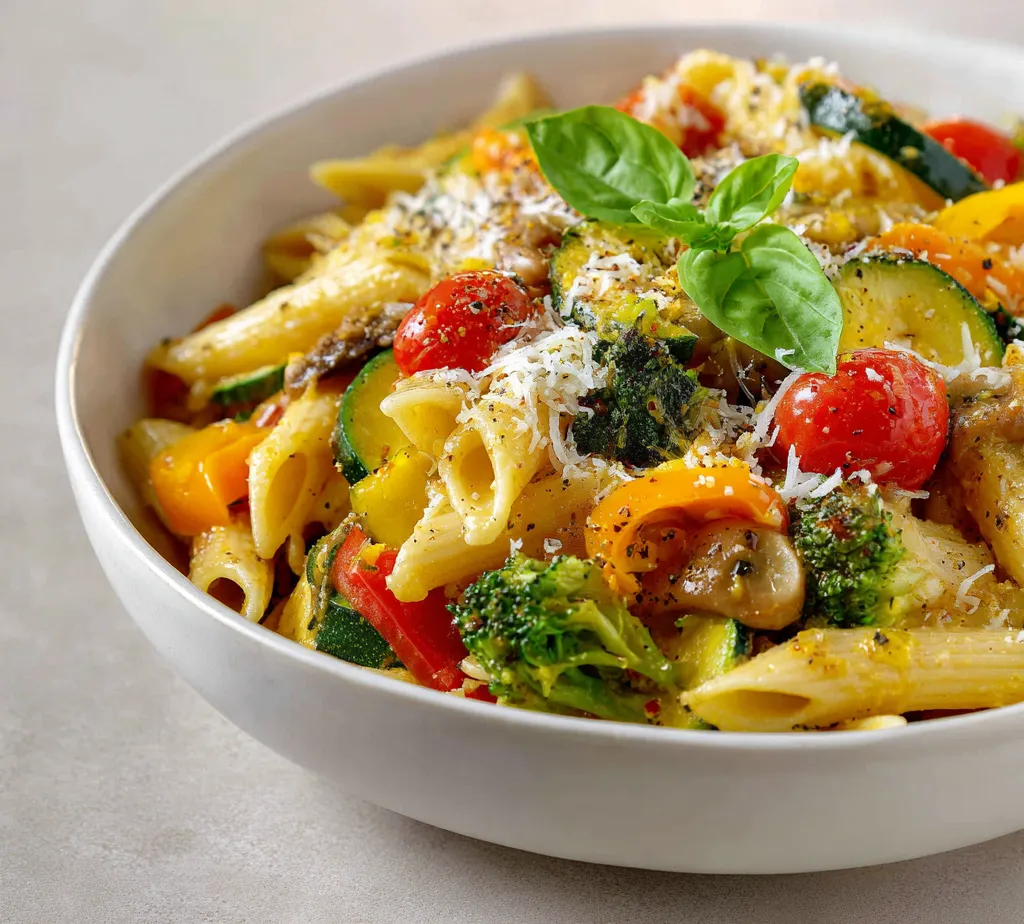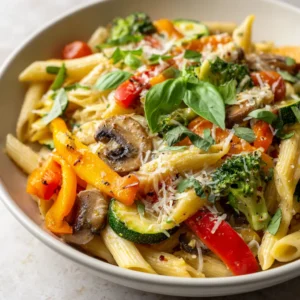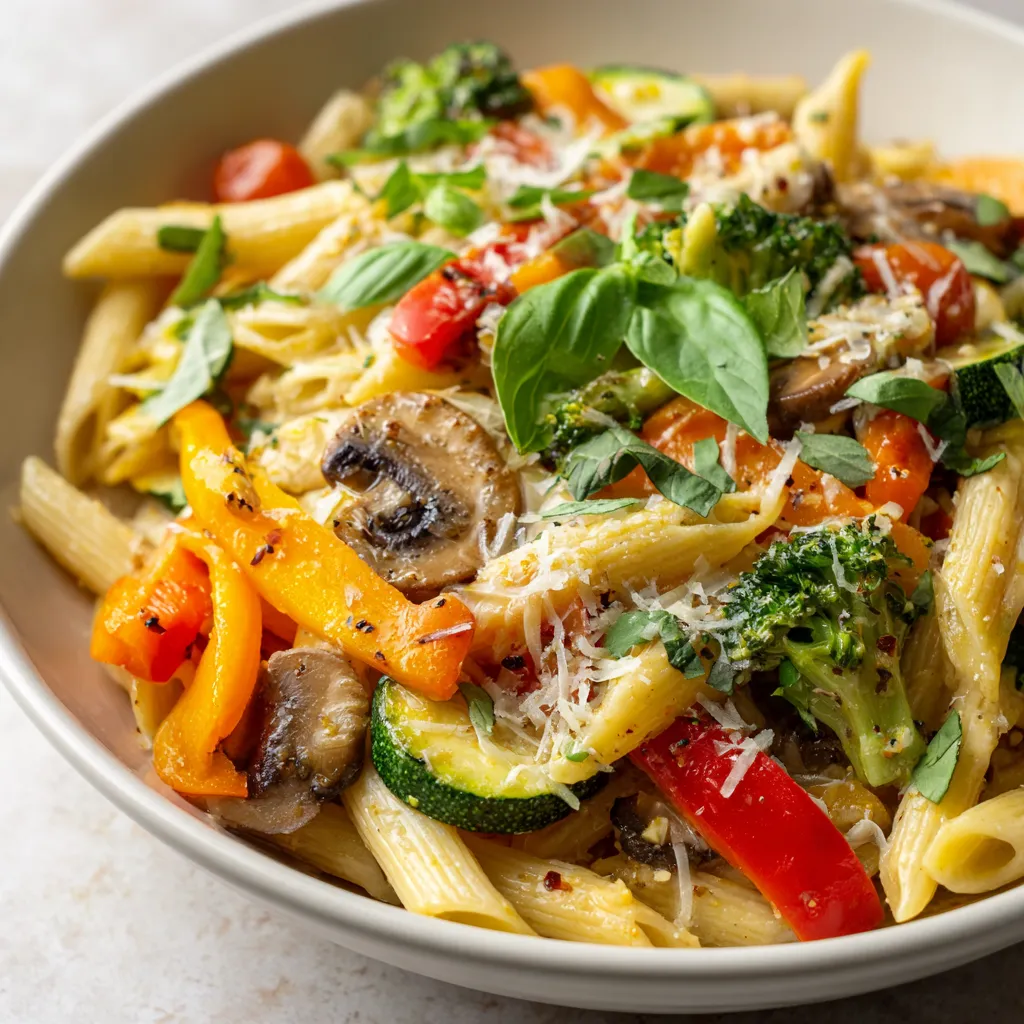Introduction
Pasta primavera is a celebration of fresh vegetables and delightful flavors, and the Herbaceous Slow-Cooked Pasta Primavera Extravaganza takes this classic dish to new heights. This vibrant and hearty pasta dish allows you to incorporate a variety of colorful vegetables in a slow-cooking process that enhances their natural flavors, resulting in a comforting meal that can be enjoyed any day of the week.
Perfect for a family gathering or a cozy weeknight dinner, this dish shines in its ability to become the star of the meal, offering both nutritional benefits and a feast for the senses. The combination of tender pasta and a bounty of seasonal vegetables bathed in rich vegetable broth creates a harmonious blend that is satisfying and wholesome. Whether you’re a vegetarian or simply looking to add more greens to your plate, this recipe is a wonderful choice, inviting you to explore the delightful textures and tastes of nature’s bounty.
Not specified in the recipe about the ideal occasion, it is evident that this dish promises to be a crowd-pleaser that brightens any table setting with its vibrant colors and tantalizing aroma.
Recipe Overview
– Total Time: 6 hours 30 minutes
– Prep Time: 15 minutes
– Yield/Servings: 4-6
– Difficulty: Not specified in the recipe.
Ingredients
– 12 oz (340g) pasta (penne or rotini)
– 1 bell pepper, diced (your choice of color)
– 1 zucchini, chopped into bite-sized pieces
– 1 cup cherry tomatoes, halved
– 1 cup broccoli florets
– 1 cup carrots, thinly sliced
– 1 cup mushrooms, sliced
– 4 cups vegetable broth
– 3 cloves garlic, minced
– 1 onion, finely chopped
– 1 tsp dried oregano
– 1 tsp dried basil
– 1/2 tsp red pepper flakes (optional, for a spicy kick)
– Salt and freshly ground black pepper, to taste
– 1/2 cup grated Parmesan cheese, for serving
– Fresh basil leaves, for garnish

Instructions
1. Prepare the Vegetables: Begin by thoroughly preparing all your vegetables. Dice the bell pepper, chop the zucchini into small pieces, halve the cherry tomatoes, slice the mushrooms and carrots, and separate the broccoli into florets.
2. Combine Ingredients: In your slow cooker, place the prepared bell pepper, zucchini, cherry tomatoes, broccoli florets, sliced carrots, and mushrooms. Next, add the minced garlic and chopped onion to the mix.
3. Season the Medley: Sprinkle the dried oregano, basil, red pepper flakes (if you’re using them), along with salt and black pepper over the vegetable mixture.
4. Add Vegetable Broth: Carefully pour the vegetable broth over the blend of vegetables, ensuring they are well-covered to promote optimal cooking.
5. Slow Cook: Secure the lid on the crockpot and set it to cook on low heat for 6 hours or on high for 3 hours, depending on your schedule. If you’re pressed for time, the high setting serves as a perfect solution!
6. Cook the Pasta: About 30 minutes prior to serving, incorporate the uncooked pasta directly into the crockpot, stirring well to ensure it’s evenly distributed throughout the broth and vegetables.
7. Enhance the Dish: Once the pasta is cooked (this should take around 30 minutes), taste the dish and adjust the seasonings as needed. For a creamier texture, consider swirling in some heavy cream or a few tablespoons of cream cheese during this step.
8. Serve: Dish out the pasta primavera into bowls and generously top with freshly grated Parmesan cheese. Finish with a sprinkling of fresh basil leaves for an aromatic and vibrant presentation.
Preparing the Vegetables
The foundation of any great pasta primavera lies in well-prepared vegetables, each contributing its unique flavor and texture. The robust nature of this dish allows for a variety of vegetables; however, the recipe specifies a lovely mix that includes bell peppers, zucchini, cherry tomatoes, broccoli, carrots, and mushrooms. Each vegetable needs to be prepped with care to ensure uniform cooking and enhance the overall aesthetic appeal of the dish.
Dicing Techniques for Bell Peppers
To achieve a balanced taste and even cooking, dicing bell peppers requires some technique. Start by removing the stem and seeds, then slice the pepper in half. Laying the half flat on your cutting board, slice it into strips and then turn those strips into cubes. This method not only provides even-sized pieces but also showcases the pepper’s vibrant color, which brightens the dish.
Chopping Zucchini for Even Cooking
Zucchini should be chopped into bite-sized pieces to match the cooking time of other vegetables. Cutting it into even chunks allows it to cook thoroughly without losing its crispness, adding a refreshing bite to your pasta primavera.
Halving Cherry Tomatoes Effortlessly
Halving cherry tomatoes can be easily done using a simple trick; place a handful between two plates and slice horizontally. This technique saves time while ensuring that the tomatoes maintain their shape and sweetness, adding juiciness as they cook down in the broth.
Slicing Mushrooms and Carrots
Mushrooms and carrots should be sliced thinly to maximize their flavor absorption during cooking. Thin slices release more moisture and enhance the dish’s overall profile. The mushrooms will yield their savory taste into the broth while the carrots provide a subtle sweetness that balances the dish’s acidity.
Combining the Ingredients
Once all your vegetables are prepared, the next step is to combine them in the slow cooker. This stage sets the foundation for the flavors to meld beautifully during the cooking process.
Layering Vegetables in the Slow Cooker
Begin by adding the prepared vegetables into the slow cooker in a manner that promotes even cooking. Layer the denser vegetables like carrots and broccoli at the bottom, as they require longer cooking times, and place the more delicate ones like cherry tomatoes and zucchini on top. This thoughtful arrangement ensures that all vegetables reach the perfect level of tenderness.
Incorporating Aromatics: Garlic and Onion
Next, introducing aromatics like garlic and onion elevates the overall flavor significantly. Mince the garlic finely to ensure even distribution, and chop the onion to release its natural sweetness as it cooks. These staples infuse the dish with a rich aroma that will tantalize the palate.
Importance of Mixing for Flavor Distribution
After placing all the ingredients in the slow cooker, gently mix them to ensure that every vegetable is coated with the additional seasonings and aromatics. This step is crucial for an even distribution of flavors, leading to a more cohesive and satisfying dish.
Seasoning the Medley
A good pasta primavera relies heavily on its seasoning. The right blend of herbs and spices will enhance the natural tastes of the vegetables while adding depth to the broth.
Choosing the Right Herbs: Oregano and Basil
Dried oregano and basil are the stars of this dish’s seasoning profile. Oregano provides a warm and slightly peppery flavor, while basil adds freshness and aromatic sweetness. When sprinkled over the vegetable medley, these herbs infuse the ingredients with their distinct tastes, creating a fragrant base that enhances each bite.
Adding Spice: The Role of Red Pepper Flakes
The optional addition of red pepper flakes is where you can customize the dish based on your preference. This subtle heat can elevate the overall flavor profile, making the dish more dynamic. If you’re serving a crowd, keep the spice level mild to ensure it’s palatable for everyone, but feel free to adjust according to your taste.
Balancing Flavors with Salt and Pepper
Finally, the seasoning would be incomplete without the classic combination of salt and freshly ground black pepper. These staples help to elevate the natural flavors of the dish, providing balance and depth. Proper seasoning is essential, so it’s wise to taste and adjust as needed as you move forward through the cooking process.

Cooking Pasta Directly in the Slow Cooker
Cooking pasta directly in the slow cooker is a unique feature of this recipe, allowing the pasta to absorb the wonderful flavors of the vegetable broth and herbs as they cook together. This method requires careful timing; adding the uncooked pasta to the slow cooker approximately 30 minutes before serving ensures that the pasta reaches the perfect al dente texture without becoming mushy. This results in a delightful combination of pasta and vegetables, with a cohesive blend of savory flavors throughout each bite.
Enhancing Flavor and Texture
After your pasta primavera has finished cooking, the opportunity to enhance its flavor and texture is pivotal to your final dish. While the slow cooking process brings out the natural sweetness of the vegetables and the underlying aromas of the herbs, there are several ways to tweak the dish further.
Adjusting Seasonings After Cooking
Once you taste the pasta primavera after cooking, don’t shy away from adjusting the seasonings to suit your palate. A pinch more salt or a sprinkle of black pepper can elevate flavors significantly. If desired, add extra dried herbs such as oregano or basil to enhance the herby notes that define the dish. For those who prefer more heat, an additional pinch of red pepper flakes can introduce a spicy kick.
Creamy Additions: Heavy Cream vs. Cream Cheese
For those who enjoy a richer experience, consider swirling in heavy cream or cream cheese just before serving. Heavy cream adds a silky richness, making the dish more indulgent, whereas cream cheese can add a tangy depth. Both options can create a beautiful, creamy consistency that marries well with the freshness of the vegetables and pasta.
Tasting and Tweaking Before Serving
Before serving, take a moment to taste and see what might be missing. Perhaps a splash of lemon juice can brighten the dish, or a few shakes of balsamic vinegar can introduce a delightful acidity. These additions can transform the dish from simply fulfilling into something truly extraordinary.
Serving Suggestions
The presentation of your pasta primavera is essential for a memorable dining experience. Here are some serving suggestions to elevate your meal.
Plating the Pasta Primavera
When serving the dish, utilize wide, shallow bowls, which allow for an appetizing display of the colorful vegetables and pasta. Use a large serving spoon to gently twirl the pasta and showcase the vibrancy of the dish, connecting the flavors visually for those at the table.
Grating Parmesan Cheese for Maximum Flavor
Grate fresh Parmesan cheese directly over the serving for maximum flavor and a fresh scent that only adds to the appeal. Consider using a microplane grater for fine shavings that melt delicately over the warm pasta.
Using Fresh Basil for Garnish
Finish off with an ample garnish of fresh basil leaves, either whole or torn, to provide a fragrant, visual contrast to the dish. Fresh herbs emphasize the herbaceous quality of the pasta primavera and invite diners in with their enticing aroma.
Presentation Tips
Visually appealing dishes often enhance the overall sensory experience, so consider these presentation tips.
Visual Appeal with Garnishes
In addition to basil, a sprig of parsley or a light dusting of chili flakes can create a beautiful contrast of colors and textures on your dish. A vibrant dash of color pairs beautifully with the earthy tones of the vegetables.
Creative Plating Techniques
Stacking the vegetables artfully or arranging them around the pasta can add sophistication to your plate. Alternatively, consider layering the pasta and vegetables in a clear dish to showcase the multitude of colors and ingredients, allowing diners to appreciate the blend of flavors before digging in.
Enhancing Flavor with Olive Oil Drizzle
A final drizzle of high-quality olive oil can also amplify the dish’s richness and impart a luscious mouthfeel. This subtle addition can elevate the overall flavor profile without overwhelming the harmony established among the other ingredients.
Pairing Suggestions
Choosing the right sides and beverages can further enhance your pasta primavera experience.
Best Side Dishes to Serve with Pasta Primavera
This dish pairs beautifully with a fresh green salad tossed with lemon vinaigrette to balance the richness of the pasta. Additionally, roasted garlic bread or a focaccia can offer a perfect accompaniment for those who enjoy sopping up the flavorful broth.
Recommended Wine or Beverage Pairings
An Italian white wine, such as a Pinot Grigio or Sauvignon Blanc, complements the herb-infused flavors beautifully. For non-alcoholic options, sparkling water with a lemon wedge adds a refreshing counterpoint to the meal.
Great Bread Options for Dipping
To enhance the dining experience further, try serving the pasta primavera with artisan bread for dipping. Sourdough or ciabatta are excellent choices, providing a satisfying contrast in texture to the soft pasta and tender vegetables.
Storing Leftovers
Proper storage of any pasta primavera leftovers is crucial to maintain its integrity and flavor.
Proper Storage Techniques
To store leftovers, allow the dish to cool completely before transferring it to an airtight container. It is best stored in the refrigerator for up to 3 days. If freezing, use a freezer-safe container, but keep in mind that the quality of the vegetables may diminish upon thawing.
Reheating Tips for Optimal Texture
When reheating, add a splash of vegetable broth or water to the dish to prevent it from drying out. Heat in a saucepan over medium-low heat or in the microwave until warmed through, stirring occasionally to ensure even heating.
Creative Ways to Use Leftover Pasta Primavera
Leftover pasta primavera can be repurposed in various ways. Consider turning it into a frittata by mixing it with beaten eggs and cooking in a skillet, or using it as a filling in omelets. Alternatively, it can be folded into a creamy soup for a comforting second-round meal.
Nutritional Benefits
This dish is not just delicious but also packed with nutritious benefits, thanks to its plethora of vegetables.
Vegetable Variety and Health Benefits
The array of vegetables in pasta primavera offers substantial health benefits, including vitamins, minerals, and fiber. Broccoli and bell peppers are excellent sources of vitamin C, while carrots provide beta-carotene, promoting overall health and wellness.
Caloric Breakdown of the Ingredients
The caloric content primarily comes from the pasta and cheese, while vegetables contribute low-calorie bulk. This makes the dish satisfying without being overly indulgent, making it suitable for various dietary preferences.
Balancing Your Meal with Pasta Primavera
When served with a protein source, such as grilled chicken or chickpeas, this pasta primavera can evolve into a balanced meal, ensuring a comprehensive nutritional profile that supports health and sustenance.
Conclusion
This Herbaceous Slow-Cooked Pasta Primavera Extravaganza is a blend of fresh flavors and vibrant textures, offering a satisfying meal for various occasions. The slow-cooking method allows the herbs and vegetables to meld, resulting in a dish that is both comforting and flavorful. With a total time of 6 hours and 30 minutes, this recipe provides an accessible, delicious option for pasta lovers.


